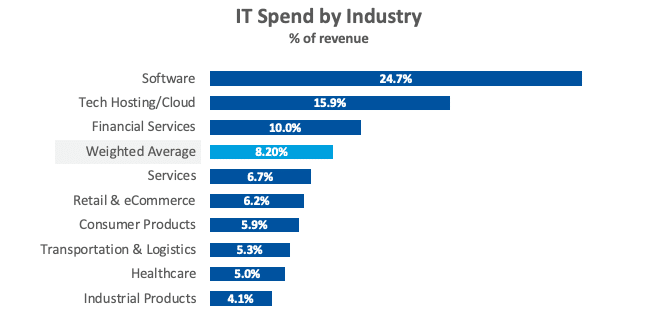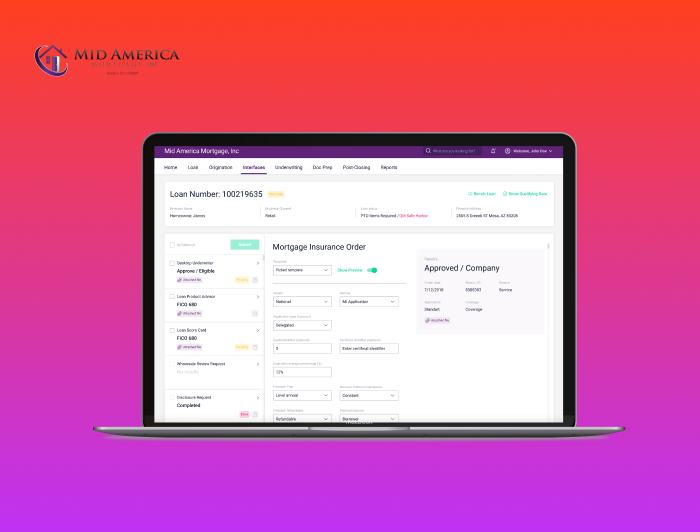
How to Reduce IT Costs: 5 IT Cost Reduction Strategies
Foundings of recent researches show that cost reduction is a global necessity. According to Deloitte’s first biennial global cost survey report, cost-cutting has become a common corporate practice in every location of four major regions–US, Latin America, Europe, and the Asia Pacific, with 86 percent of global respondents indicating that their organizations will implement cost-cutting efforts in the next 24 months.
IT infrastructure is one of the few company components that may be adjusted to reduce costs. As of 2019, IT spending in the financial services business ranged from 4.4 percent at the 25th percentile to 11.4 percent at the 75th percentile, according to Statista. When evaluating IT costs, business leaders must consider their company’s strategic context to determine where savings and investments are required.
While IT cost are often considered a fixed expenditure, most IT budgets include enough flexibility to adjust to changing business cycles and needs. According to McKinsey, IT costs can be cut by up to 30 percent by adopting a “bare minimum” approach in the time of a crisis. Let’s look at information technology cost savings and top IT cost reduction strategies for your business.
Content Outline:
What Is IT Cost Reduction?
IT infrastructure is widely defined as a set of information technology components that are the basis of IT services, usually physical components and various software and network components. The IT budget is a broader concept covering the costs of hardware, software, employees, outsourcing, disaster recovery, and office space required to support IT within the company.
Finding and removing sources of waste, underutilization, or low business value within the IT budget is known as IT cost reduction. IT cost reduction is also known as information technology cost savings or IT cost optimization. This method generates savings that can be spent on new technology to support company growth or lower the size of the IT budget.
What Kind of Companies Require IT Cost Reduction?
IT costs account for 7.5 percent of revenue on average. According to the TechTarget, the average small business (less than $50 million in revenue) spends 6.9 percent of its revenue on IT, mid-sized businesses ($50 million to $2 billion) spend 4.1 percent of their revenue, while larger corporations (above $2 billion) spend only 3.2 percent of their revenue on IT.
Therefore, the subject of how to minimize IT infrastructure costs is vital for any kind of business – small, medium, or large. This figure is far too high for many businesses, as their expenses are astronomically high.
Startups
For startups cutting IT costs is a viable option as they are typically held accountable to investors for the capital they have raised. As a result, cutting IT costs aids potential entrepreneurs in maximizing their budgets and creating compelling products within their constraints. IT cost reduction can boost the startup’s net profit and profit margin and help it survive in the tech market and grow and expand.
Small and Medium Enterprises (SME)
Every country’s commercial fabric includes small and medium-sized enterprises (SMEs). Their market entry is critical for the creation of jobs and riches in all parts of the world. Curbing spending is a sensible strategy for small and medium business owners to enhance their cash flow without putting their companies at risk. IT cost reduction helps SMEs stay afloat.
Enterprises
In big enterprises decreasing costs frequently contradicts long-standing corporate practices. There are particular C-level specialists, like Chief Financial Officer (CFO) or Chief Information Officer (CIO), in charge of IT cost reduction and cost cutting in general. CFOs and CIOs examine IT cost-cutting programs and strategies, providing an objective assessment of the actual IT expenses saved once they are completed.
Integration
Your loan software cannot be an island. It needs to interact with other organizations and service providers. Start the design process by answering the following questions:
- Should you capture information from major credit bureaus?
- Should you accept payments from a variety of service providers?
- Should you integrate customer relationship management (CRM) platforms to manage marketing client campaigns?
- Should you integrate with your accounting systems?
- Should you integrate with collection and credit organizations if you need to proceed to a collections process?
2. Lack of Expertise
- Should you capture information from major credit bureaus?
- Should you accept payments from a variety of service providers?
- Should you integrate customer relationship management (CRM) platforms to manage marketing client campaigns?
- Should you integrate with your accounting systems?
- Should you integrate with collection and credit organizations if you need to proceed to a collections process?

3. Higher Prices
There is no reason to dwell too much on this one, as this is a complete hoax. There is actually no explanation to how this superstition emerged on the surface, while facts remain facts. The average hourly rate per one developer in the United States is $150; in Europe, it amounts to €150. Meanwhile, if we’re talking about Asia, Africa, and Eastern Europe (where many countries are still not part of the European Union), the damage will be approximately $75. It seems like the difference is even more than tangible, given that the quality of services might be even better.
4. Irresponsible Vendors
When you’ll hear about irresponsible vendors from outside Europe, may you ask yourself a question of how territorial affiliation can be the cause of irresponsibility? While you’re in the IT business, it is quite probable that logical reasoning is one of your core virtues. There are both responsible and irresponsible vendors within Europe and outside its boundaries. Hence, when it comes to choosing a software outsourcing company, think of their tech expertise, portfolio, and clients reviews, as this is where the grain of truth lies.

What Industries Benefit Most From IT Cost Reduction?

What Are The Areas Where You Could Reduce IT Costs?
As we see, any company regardless of the size and the industry is always looking for ways to save money. Looking at the technology budget line items, it is always challenging to decide what can be cut off without harm to your business performance. IT costs may not be as predictable as you assume. Let’s take a look at the areas where you might save money on IT costs.
Software
Your company probably pays for software like Microsoft Office 365 or Adobe Photoshop. You can often find cost savings by reviewing these software agreements. You may be able to renegotiate your membership. In some cases, you’re paying for software that none of your staff use. Then it makes sense to minimize or eliminate such software. Additionally, consider using open-source software to save money on software acquisition and maintenance.
Hardware
It’s possible that your current hardware is underutilized, needs replacement, or has lost productivity. Look for ways to execute apps on less expensive devices or connect multiple PCs to replace expensive server hardware. Standardizing platforms can also help cut IT expenditures while maintaining consistency.
Cloud computing
Moving to the cloud is another approach to reducing IT infrastructure costs. According to Forbes, the worldwide cloud computing market is predicted to grow from $371.4 billion in 2020 to $832.1 billion in 2025. Moving data backup to the cloud to replace an on-premises server can save money, not to mention the energy savings from not having to power the components that have been replaced.
Databases
Virtualizing your databases can help your company save on storage and save money. It has the potential to boost the productivity and flexibility of your business. Begin virtualizing your lower-risk databases, such as LDAP databases, in development and production. You’ll operate virtualized databases, which may appear more complex at first. Still, the flexibility and productivity improvements it delivers aid with cost reduction and outweighs any disadvantages for many Enterprise IT organizations.
IT Staff
Outsourcing IT staff allows you to save money on infrastructure and onsite IT staffing. Hiring a remote offshore workforce in Eastern Europe is another option to save product development costs. It might help you save money and get high-quality work at a low hourly rate. Additionally, your company can pay a monthly fee or utilize a pay-per-use basis to get security, IT help desk support, and backup services.
5 Applicable Strategies to Reduce Your IT Costs
Use Open Source Software
Open-source software eliminates both the upfront and ongoing software acquisition and maintenance costs. However, open-source is much more than a cost-cutting strategy. You can make your changes to open-source software since you have access to the source code.
Furthermore, because engineers from a variety of firms generate code updates, the program often improves faster than it would if only one company supported it. Finally, if you have a problem, you are not limited to the software provider for assistance but instead, have a variety of possibilities.
Migrate to Cloud
Running your business on a physical server may incur unnecessary costs. Storage and hardware no longer need to be on-site, and because resources are only used when needed, the cost of renting can be substantially lower than the cost of owning. Customers can browse for the cheapest price from cloud providers using containers, which can be advantageous.
Moving your data to the cloud could save you thousands dollars by removing on-premises costs. Furthermore, cloud solutions eliminate the need for you to maintain or update your hardware. Instead, you may quickly alter all of the settings whenever you wish.
Invest in Automation
Sometimes investing is the best strategy to reduce IT costs from middle- and long-term perspective. It is precisely the case when we speak about investing in the automation of processes. Instead of doing a lot of manual work, automating it once and for all can save a lot of labor costs.
Here are some examples of processes that can be automatized:
- Automation of software testing
- Code reviews
- Job scheduling
- Production Monitoring
- Recruiting processes
Follow Best Practices from the Beginning
Doing things right the first time may appear to be a simple concept, but it is an idea that must pervade your organization’s culture to be genuinely effective. Allowing shortcuts in coding or programming rather than following best practices, such as user testing and code review, can result in costly problems when a crucial business application fails.
According to Atlassian, IT downtime is anticipated to cost anywhere between $100,000 and $540,000 per hour. However, costs differ significantly by industry and company. As we all move to the internet of things, this will only increase (IoT). Following best practices prevent downtime, but it also reduces tech debt, allowing developers to focus on projects that save money and generate revenue.
Outsource Software Development
Another approach to cut IT infrastructure costs is to outsource software development offshore. According to Statista, revenue in the IT Outsourcing segment is expected to reach $144.80 billion in 2022. These data show how popular and convenient IT staff outsourcing has become.
A shift to software development outsourcing might help you cut IT costs and get high-quality work at a low hourly rate. Moreover, offshore outsourcing is an excellent choice if you want a self-manageable dedicated engineering team with niche expertise in various tech stacks and full involvement in the project. Contact us if you want to know more about what outsourcing NerdySoft can offer.

How to Measure Your Cost Reduction Effectiveness?
It is critical to assess your IT cost reduction strategies’ influence on the organization. Examine each initiative and determine whether it was successful. If yes, how large was it, and if the risk was worth it. Companies that take the time to match their cost-cutting programs with their overall strategy reap significant rewards.
To run a neobank, you need an appropriate license in each of your operating jurisdictions. When starting up a neobank, you need to decide what range of services you want to provide and the path you want to get to those services. Do you want to start small and grow or start with a big bang? You can start with a financial institution license and increase your service base from there. If you operate outside of the United States, you may be able to start with a virtual banking license. You can get straight to getting your banking license. If that is too big of a reach, you could affiliate with an existing licensed bank or become a subsidiary to one.
Effective IT cost reduction is a great method to boost your company’s efficiency. When working with a tight budget or limited resources, cutting IT costs can save your product’s life. One of the methods to save expenses without sacrificing quality is to outsource a dedicated software development team.
NerdySoft is a full-cycle software development company With vast expertise in FinTech, CreditTech, HealthTech, and E-commerce, NerdySoft develops scalable solutions for the most complex technical issues that businesses of all sizes face across industries.
Contact us if you want to know more about how NerdySoft team can help you reduce your IT costs.
Latest Insights
Stay informed on the latest updates and trends to follow in financial services, digital transformation and software development from NerdySoft





